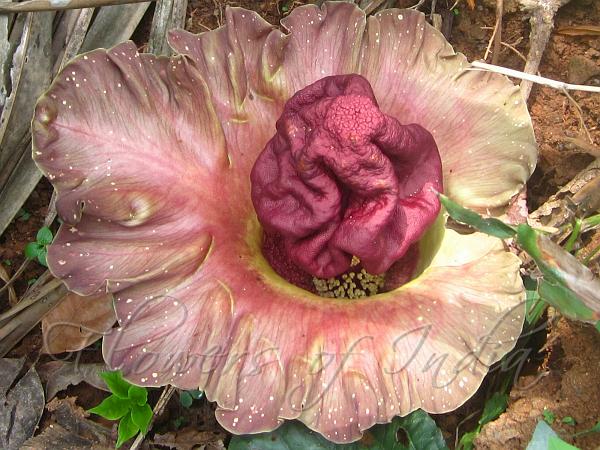|
| Elephant Foot Yam |
|

|

| File size | 566335 |
| Original date | |
| Resolution | x |
| Flash | Flash did not fire, auto |
| Focal length | 5.0mm |
| Exposure time | 1/60s |
| Aperture | 2.8 |
| Focus Distance | |
| Metering Mode | $meteringMode |
| Camera make | Canon |
| Camera model | Canon IXUS 115 HS |
| Sensor type |
|
|
|
|
Photo: |
Botanical name: Amorphophallus paeoniifolius Family: Araceae (Arum family)
Synonyms: Amorphophallus campanulatus
Synonyms: Amorphophallus campanulatus
Elephant Foot Yam is perhaps one of the ugliest
flowers in the world and to accompany it, it has one of the worst
scents that you can imagine. It's hard to get close to the flower when
it's releasing its smell. But the foul odor only lasts for a few hours
after the flower opens. The plant only blooms when mature and even so
it doesn't bloom every year. Flowers last only about 5 days. Even more
interesting, during this phase the plant generates heat. The heat and
the smell mimics rotting flesh to attract the flies that will pollinate
the flower. Elephant yam is a striking aroid with a flower spike
crowned with a bulbous maroon knob and encircled by a fleshy maroon and
green-blotched bract. The solitary leaf, which emerges after the
flowering parts, resembles a small tree. In India this species as a
crop is grown mostly in Bihar, West Bengal, Kerala, Karnataka, Andhra
Pradesh, Maharashtra and Orissa.
Medicinal uses: The elephant-foot yam is
widely used in Indian medicine and is recommended as a remedy in all
three of the major Indian medcinal systems: Ayurveda, Siddha and Unani.
The corm is prescribed for bronchitis, asthma, abdominal pain, emesis,
dysentery, enlargement of spleen, piles, elephantiasis, diseases due to
vitiated blood, and rheumatic swellings. Pharmacological studies have
shown a variety of effects, specifically antiprotease activity,
analgesic activity, and cytotoxic activity. In addition it has been
found to be a potentiator for further reducing bacteria activity when
used with antibiotics.
The elephant-foot yam is
widely used in Indian medicine and is recommended as a remedy in all
three of the major Indian medcinal systems: Ayurveda, Siddha and Unani.
The corm is prescribed for bronchitis, asthma, abdominal pain, emesis,
dysentery, enlargement of spleen, piles, elephantiasis, diseases due to
vitiated blood, and rheumatic swellings. Pharmacological studies have
shown a variety of effects, specifically antiprotease activity,
analgesic activity, and cytotoxic activity. In addition it has been
found to be a potentiator for further reducing bacteria activity when
used with antibiotics.
Medicinal uses:
 The elephant-foot yam is
widely used in Indian medicine and is recommended as a remedy in all
three of the major Indian medcinal systems: Ayurveda, Siddha and Unani.
The corm is prescribed for bronchitis, asthma, abdominal pain, emesis,
dysentery, enlargement of spleen, piles, elephantiasis, diseases due to
vitiated blood, and rheumatic swellings. Pharmacological studies have
shown a variety of effects, specifically antiprotease activity,
analgesic activity, and cytotoxic activity. In addition it has been
found to be a potentiator for further reducing bacteria activity when
used with antibiotics.
The elephant-foot yam is
widely used in Indian medicine and is recommended as a remedy in all
three of the major Indian medcinal systems: Ayurveda, Siddha and Unani.
The corm is prescribed for bronchitis, asthma, abdominal pain, emesis,
dysentery, enlargement of spleen, piles, elephantiasis, diseases due to
vitiated blood, and rheumatic swellings. Pharmacological studies have
shown a variety of effects, specifically antiprotease activity,
analgesic activity, and cytotoxic activity. In addition it has been
found to be a potentiator for further reducing bacteria activity when
used with antibiotics. | Identification credit: Shivaprakash Nedle | Photographed in Karnataka. |
• Is this flower misidentified? If yes,